January6
Happy snow day tomorrow! 🙂 Oh my goodness can you believe how cold it is outside? According to WEEK News 25 here are the current weather conditions:
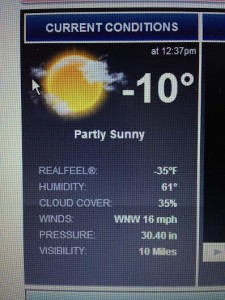
This got me thinking about other places that might be this cold. Check out what I found out about the South Pole: http://www.timeanddate.com/weather/antarctica/south-pole
WHOA! It is colder here than the South Pole. When I visited the website the current conditions were: -9 degrees and -29 degrees windchill. Did it change when you checked it?
I also wondered what is a wind chill? So I headed over to Wonderopolis and look what I discovered: http://wonderopolis.org/wonder/when-does-the-wind-chill/
My teacher friends on Facebook were also posting some pretty neat things to do on a snow day so I thought I would share. Since it is so COLD be safe and ask an adult to help you.
1.) Boil a cup of water in the microwave, then throw the water outside your door and see what happens to the water. I had to try this so check out my videos below. How and why do you think this happened?
trim.C3E7BB5D-1123-4215-BDB9-2E764A66DA65
trim.B6A37780-AC89-4A63-9B7D-0B7AAB5A6260
2.) Make Snow Ice Cream! (If you do this please be sure to leave us a comment about the taste and if any changes need to happen in the recipe)
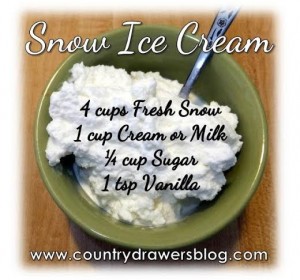
3.) Fill two ice cube trays with with water. Put on outside and one in your freezer inside. Which one froze faster? Why do you think so? (leave us a comment about it)
Stay warm and snuggle up with a good book over the next few days. Be sure to check out the Pitzer Post. I have udapted it to take into account the snow day 1/7/14: https://sososeussey.edublogs.org/2014/01/04/the-pitzer-post-17/
October7
It is hard to believe that our caterpillars have gone through all of the stages of their life cycle. Today we released our butterflies in the school’s butterfly garden. We each got to hold our butterfly and say goodbye. It tickeled a lot and made us giggle. Check out our video to see what we learned:
Our Life Cycle Adventures from Stefanie Pitzer on Vimeo.
Make sure to click the full screen option on the bottom right. By viewing it full screen you won’t get anything cut off. 🙂
October3
I came into the classroom to discover quite a few fluttering friends:
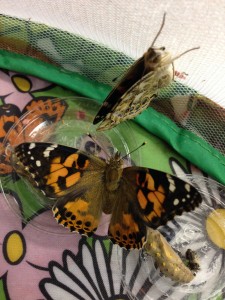
WE HAVE BUTTERFLIES!!!
This week we learned that butterflies use a proboscis, which is like a straw to eat nectar. Since our butterflies are in our classroom, we have a small cup of sugar and water that will act as a nectar substitute. We also learned that the red dye we will see in our net is not blood but meconium. Meconium is the liquid that comes out of the chrysalis. It has a pigment in it that turns things red. The butterflies when they first come out flap their wings so they can dry them. Since their wings are wet at the beginning, it is hard for them to fly. After they flap their wings and practice they become much better fliers.
We can’t wait to see more butterflies emerge. After more have gone through their life cycle, we will be releasing the butterflies in the school’s butterfly garden.
September25
Look at what happened to 10 of our caterpillars last night?!
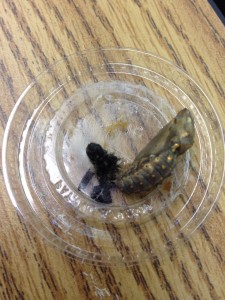
Our first chrysallis!
Do you see the black ball to the left of the chrysallis?! That is the caterpillar’s head that popped off. It has to make a new head to become a butterfly. The chrysallis is a golden brownish color with some bumps on it. Where do you think the top of the butterfly will be and where will the bottom be? How long do you think it will take to become a butterfly?!
September18
Some creepy crawlers join second grade land today. Our painted lady caterpillars have arrived. Each student has their very own cup filled with nutrient (hollyhock, supplements, water and other essentials) and a wiggley caterpillar.
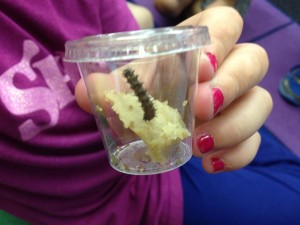
Check out our caterpillars!
We learned so many neat facts already:
1.) Caterpillars are insects with 3 main parts of their body: abdomen, thorax and head
2.) Caterpillars breathe through holes in their abdomen. (They have 16 breathing holes.)
3.) Water comes from the food they eat in the cup.
4.) If we see light or dark green balls in our cup this is called frass (caterpillar poop).
5.) If we see fuzzy black lumps, this is our caterpillar growing and shedding it’s skin. This is called molting.
We can’t wait to learn more about our fuzzy friends. We each gave our caterpillars names so be sure to ask your child what name they picked out.
Mrs. Ellis even got one of our critters and she named him Carle (after Eric Carle author of The Very Hungry Caterpillar). She is going to observe and learn right along with us, tweet about her learning and take pictures of her new friend. You can follow his adventures by checking out the following hashtag: #carlecam
What is your child most excited to learn about? What do they wonder about when it comes to our caterpillars? Do you know any fun facts about caterpillars that you could share with us?
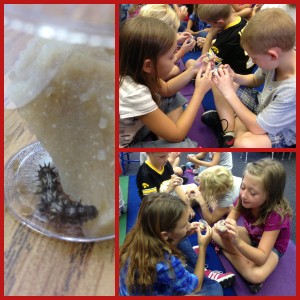
Sharing observations with our friends

Mrs. Elllis loves her new friend: Carle!
September17
Look what arrived in our classroom today?
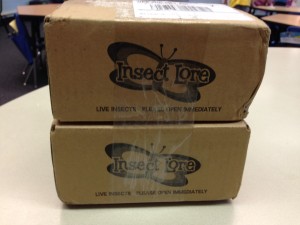
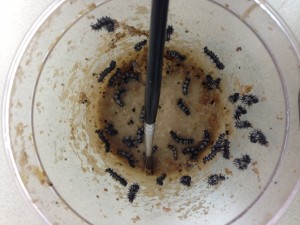
Who is excited to see more tomorrow?!
September4
Please be sure to ask your child about becoming a scientist today. In order to get our brains working and thinking like a scientist, we watched this video: The Fairy Scientist
While we watched we listened for key words about being a scientist. We came up with the following list:
1. observation
2. scientist
3. inquiry
4. deduction
5. evidence
6. proof
We talked about how important it was for scientists to think, try new things, ask questions and work hard to find a solution. After that we learned there is a method called the Scientific Method. These are steps we can use when conducting an experiment or wanting to explore something further. We listened for the steps carefully while listening to: Scientific Method Rap. Here are the steps we hear : observation, make a prediction, make a hypothesis, ask questions, analyze data, conduct an experiment and draw conclusions. Those were big words but we were able to use what we know and picture clues to determine what it means to be a scientist. After the video, we went outside with our notebooks to record observations. It is very important when recording observations to be specific and include lots of detail.
We will continue to use the scientific method throughout the year in order to help us understand our science concepts. Please encourage your child to visit our wiki: http://dunlapgradesecond.pbworks.com/ and visit the science pages. Here you will find several videos as well as opportunities to observe, predict, analyze, record and draw conclusions.
There is also a wonderful website called Wonderopolis: http://wonderopolis.org/ This website is a fantastic place to wonder and explore. They have a wonder of the day and hundreds of ways to learn about all sorts of topics and subjects.
What do you wonder about? Here’s to all of the wonders we will think of this year!








